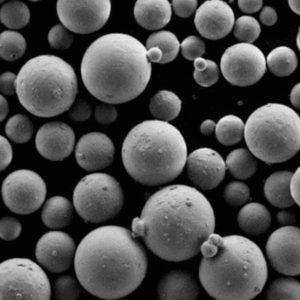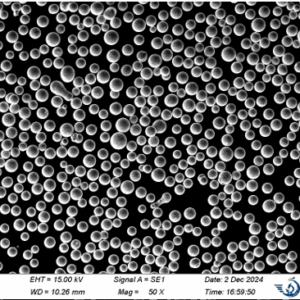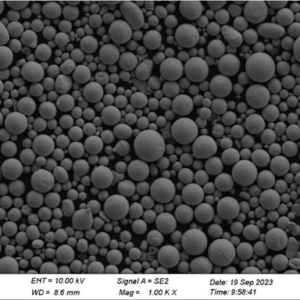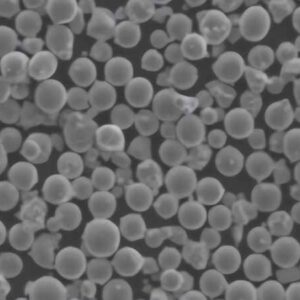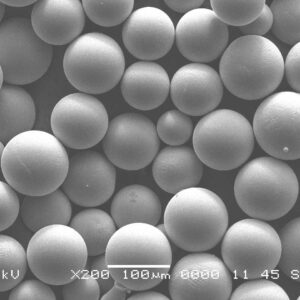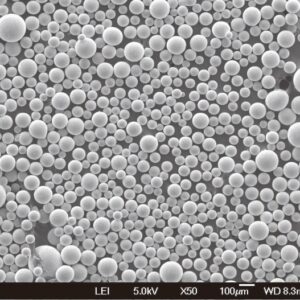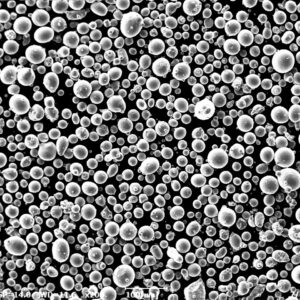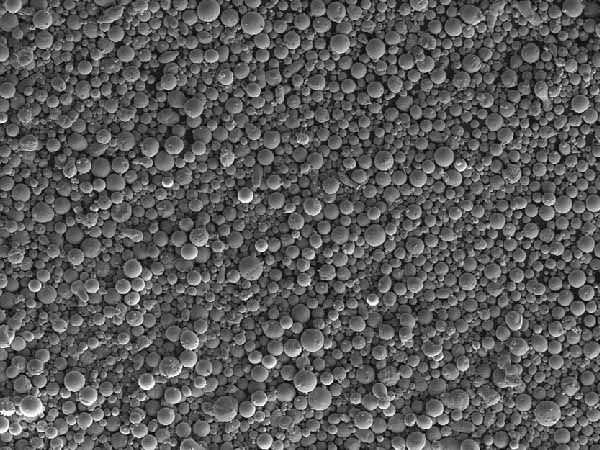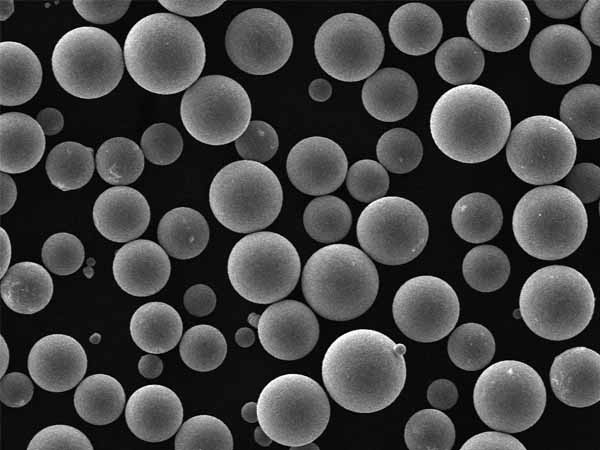マルチレーザー印刷 は、特に金属積層造形(AM)において、製造風景に革命をもたらしている。このプロセスには、高い造形速度、複雑な設計、材料の効率的な使用など、数多くの利点がある。しかし、最終製品の品質と性能は、このプロセスで使用される金属粉末にかかっています。粉末の選択は非常に重要で、表面仕上げからプリント部品の機械的特性まで、すべてに影響します。このガイドでは、マルチレーザー印刷用の粉末の世界を深く掘り下げ、様々な金属粉末モデル、その特性、用途などを探ります。
マルチレーザー印刷用粉末の概要
マルチレーザープリンティング」という用語は、複数のレーザーを同時に使用して金属粉末を固体部品に融合させる金属積層造形技術のサブセットを指す。この方法は、航空宇宙、自動車、医療機器など、精度、強度、材料効率が最優先される産業で一般的に採用されている。これらのプロセスで使用される金属粉末は通常、細かく等級分けされており、一貫した品質を確保するために厳しい基準を満たす必要があります。
マルチレーザー印刷用金属粉末の主な特徴:
- 粒子径: 通常、10~50ミクロンの範囲である。
- 真球度: 真球度が高いことは、良好な流動性と安定したレイヤリングのために極めて重要である。
- 純粋さ: 粉末は、酸素と窒素の含有量を最小限に抑えた高純度のものでなければならない。
- 素材構成 用途によって異なる合金が使用される。
一般的に使用される金属粉末は以下の通り:
- ステンレス鋼(316L、17-4 PHなど)
- チタン合金(Ti6Al4Vなど)
- アルミニウム合金(AlSi10Mgなど)
- ニッケル基超合金(インコネル718など)
- コバルトクロム合金

粉体組成 マルチレーザー印刷
金属粉末の組成は、印刷プロセス中の挙動と最終部品の特性を決定する基本的な側面です。様々な金属粉末は、強度、耐食性、熱安定性などの特定の要件を満たすように設計されています。
一般的な金属粉末の組成:
| 金属粉 | 構成 | プロパティ |
|---|---|---|
| 316Lステンレス鋼 | 鉄(Fe)、クロム(Cr)、ニッケル(Ni)、モリブデン(Mo)、マンガン(Mn) | 優れた耐食性、良好な機械的特性、医療用途で一般的 |
| 17-4 PHステンレス鋼 | 鉄(Fe)、クロム(Cr)、ニッケル(Ni)、銅(Cu)、ニオブ(Nb) | 高強度、優れた耐食性、析出硬化型 |
| Ti6Al4V(チタン合金) | チタン(Ti)、アルミニウム(Al)、バナジウム(V) | 高強度重量比、優れた耐食性、生体適合性 |
| AlSi10Mg(アルミニウム合金) | アルミニウム(Al)、ケイ素(Si)、マグネシウム(Mg) | 軽量、良好な熱伝導性、高強度 |
| インコネル718(ニッケル超合金) | ニッケル(Ni)、クロム(Cr)、鉄(Fe)、モリブデン(Mo)、ニオブ(Nb)、チタン(Ti)、アルミニウム(Al) | 優れた高温強度、耐食性 |
| CoCr(コバルトクロム合金) | コバルト(Co)、クロム(Cr)、モリブデン(Mo)、ニッケル(Ni) | 高い耐摩耗性、生体適合性、高温での優れた強度 |
| マレージング鋼 | 鉄(Fe)、ニッケル(Ni)、コバルト(Co)、モリブデン(Mo)、チタン(Ti) | 非常に高い強度と優れた靭性を持ち、航空宇宙や工具用途に使用される。 |
| ハステロイX(ニッケル合金) | ニッケル(Ni)、モリブデン(Mo)、クロム(Cr)、鉄(Fe) | 優れた高温強度、優れた耐酸化性 |
| CuNi2SiCr (銅合金) | 銅(Cu)、ニッケル(Ni)、シリコン(Si)、クロム(Cr) | 高い導電性、優れた機械的特性 |
| 工具鋼(例:A2、D2) | 鉄(Fe)、炭素(C)、クロム(Cr)、モリブデン(Mo)、バナジウム(V) | 高硬度、耐摩耗性、金型製造に使用 |
マルチレーザー印刷用粉末の特性
マルチレーザー印刷における金属粉末の性能は、粒度分布、モルフォロジー、流動性、純度などのさまざまな特性に影響される。これらの要因は、印刷品質、印刷部品の機械的特性、および全体的なプロセス効率に直接影響します。
主な特徴
| 特徴 | 説明 | 印刷への影響 |
|---|---|---|
| 粒度分布 | 一般的に10~50ミクロンの範囲にある。微細なパウダーは解像度が高く、粗いパウダーは造形速度が速い。 | 層厚、表面仕上げ、機械的特性に影響する。 |
| 形態学 | 流動性と充填密度に優れる球状粒子が好ましい。 | 均一なレイヤリングを保証し、欠陥のリスクを低減する。 |
| 流動性 | 再コーティング工程で均一な層を形成するためには、パウダーは自由に流れなければならない。 | 流動性が悪いと、空隙や不完全融着といった欠陥につながる。 |
| 純度 | 高純度であることが重要であり、酸素、窒素、その他の元素による汚染を最小限に抑える必要がある。 | 汚染物質は、弱点、機械的特性の低下、耐食性の低下につながる可能性がある。 |
| 球形度 | 高い真球度は粉末の流動性と充填密度を向上させる。 | パウダーベッドの均一性を高め、より高品質な印刷を実現。 |
| かさ密度 | 粉末の嵩密度は、一定の体積に充填できる材料の量に影響する。 | 粉末の使用効率と最終部品の重量に影響する。 |
マルチレーザー印刷用粉末の用途
マルチレーザープリンティングの多用途性と利用可能な幅広い金属粉末により、この技術は様々な産業に適している。各用途では、高強度や耐摩耗性から生体適合性や熱伝導性まで、特定の材料特性が要求される。
産業への応用:
| 産業 | 申し込み | 好ましい金属粉末 |
|---|---|---|
| 航空宇宙 | 軽量構造部品、タービンブレード、熱交換器。 | Ti6Al4V、インコネル718、ハステロイX |
| 自動車 | エンジン部品、軽量構造物、耐熱部品。 | AlSi10Mg, 316L ステンレス鋼, マルエージング鋼 |
| メディカル | 生体適合性と耐食性を必要とするインプラント、補綴物、手術器具。 | Ti6Al4V、CoCr、316Lステンレス鋼 |
| 石油・ガス | 高い耐食性と耐摩耗性が要求される過酷な環境用部品。 | インコネル718、ハステロイX、17-4 PHステンレス鋼 |
| 金型 | 高精度で長寿命の高強度工具と金型。 | 工具鋼、マルエージング鋼、17-4 PHステンレス鋼 |
| エネルギー | タービン、発電機、その他エネルギー生産設備の部品。 | インコネル718、ハステロイX、CoCr |
| エレクトロニクス | ヒートシンク、導電経路、その他優れた熱的・電気的特性を必要とする部品。 | CuNi2SiCr、AlSi10Mg、316Lステンレス鋼 |
| ジュエリー | 美的価値の高い、カスタマイズされた複雑なデザイン。 | CoCr、Ti6Al4V、316Lステンレス鋼 |
| ディフェンス | 軍用車両、武器、防具用の高性能部品。 | インコネル718、マルエージング鋼、Ti6Al4V |
仕様、サイズ、等級、規格
金属粉を選択する場合 マルチレーザー印刷そのためには、粉体に適用される仕様、サイズ、等級、規格を考慮することが不可欠です。これらの要素により、粉末が意図された用途の要件を満たし、業界標準に準拠していることが保証されます。
仕様と規格:
| 金属粉 | 仕様/規格 | 粒子径範囲 | グレード |
|---|---|---|---|
| 316Lステンレス鋼 | アストマ F138、F139、F3184 | 15-45ミクロン | メディカルグレード、インダストリアルグレード |
| 17-4 PHステンレス鋼 | A564, A693 | 10~50ミクロン | 析出硬化 |
| Ti6Al4V | ASTM F1472、F2924 | 20~45ミクロン | グレード5(ELI) |
| AlSi10Mg | ISO 9001、ASM F3318 | 20-63ミクロン | AMグレードの高純度 |
| インコネル718 | ASMB637、AMS5662 | 15-53ミクロン | 超合金 |
| マレージング鋼 | AMS 6514、ASM A646 | 15-45ミクロン | 18Ni-300 |
| ハステロイX | ASMB435、AMS5754 | 15-53ミクロン | 高温合金 |
| CuNi2SiCr | DIN 17666、ASM B422 | 20-63ミクロン | 高導電グレード |
| 工具鋼 | A681, ISO 4957 | 15-45ミクロン | A2, D2 |
サプライヤーと価格詳細
マルチレーザー印刷用金属粉末の市場は広大で、数多くのサプライヤーが幅広い製品を提供している。価格は、材料、粒度、純度、サプライヤーによって大きく異なる場合があります。
サプライヤーと価格設定:
| サプライヤー | 金属パウダー | 価格(1kgあたり) | コメント |
|---|---|---|---|
| LPWテクノロジー | ステンレス, チタン, アルミニウム, インコネル | $150 – $600 | 高品質のパウダー、オーダーメイドのソリューション |
| カーペンター添加剤 | ステンレス, チタン, ニッケル合金, コバルト-クロム | $200 – $800 | 幅広い合金オプション、グローバルサプライヤー |
| サンドビック・オスプレイ | チタン, アルミニウム, 工具鋼, ステンレス鋼 | $180 – $750 | 安定した品質、広範な研究開発能力 |
| AP&C(GEアディティブ) | チタン、アルミニウム、ニッケル合金 | $250 – $1000 | 高品質の球状パウダーに特化 |
| ヘガネスAB | ステンレス鋼, 工具鋼, コバルト-クロム | $150 – $500 | 持続可能性と技術革新への強いこだわり |
| テクナ | チタン、アルミニウム、ニッケル合金 | $200 – $900 | 高度なプラズマ霧化プロセス |
| オベール&デュバル | ニッケル基超合金, ステンレス, チタン | $300 – $1000 | 航空宇宙グレードの高級パウダー |
| イーオーエス | チタン、アルミニウム、ニッケル合金、コバルトクロム | $250 – $1200 | EOSマシンに最適化された高性能パウダー |
| カーテック | マルエージング鋼, ニッケル合金, ステンレス鋼 | $200 – $900 | 高強度合金に特化 |
| アメテック | チタン、ニッケル合金、ステンレス鋼 | $180 – $850 | 様々な産業向けの幅広い金属粉末 |
金属粉末の利点と限界 マルチレーザー印刷
適切な金属粉末を選択することは、マルチレーザー印刷プロセスを最適化する上で極めて重要である。粉末の種類にはそれぞれ利点と制限があり、印刷部品の全体的な性能に影響します。
利点と限界を比較する:
| 金属粉 | メリット | 制限事項 |
|---|---|---|
| 316Lステンレス鋼 | 優れた耐食性、優れた機械的特性、広く入手可能 | 17-4PHのような他の合金に比べて強度が低い。 |
| 17-4 PHステンレス鋼 | 高強度、優れた耐食性、析出硬化型 | 316Lより高価、複雑な熱処理が必要 |
| Ti6Al4V | 高強度重量比、優れた耐食性、生体適合性 | 高コスト、酸素に敏感なため印刷が難しい |
| AlSi10Mg | 軽量、良好な熱伝導性、高強度 | チタン合金に比べて低い耐疲労性 |
| インコネル718 | 優れた高温強度、耐食性 | 高価、後加工が難しい |
| CoCr | 高い耐摩耗性、生体適合性、高温での優れた強度 | 非常に高価で、加工が難しい |
| マレージング鋼 | 非常に高い強度と優れた靭性を持ち、航空宇宙や工具用途に使用される。 | エージング処理が必要で、耐食性は限定的 |
| ハステロイX | 優れた高温強度、優れた耐酸化性 | 非常に高価で、ニッケル含有量が多いため印刷が難しい。 |
| CuNi2SiCr | 高い導電性、優れた機械的特性 | 強度が低く、高温用途には適さない。 |
| 工具鋼 | 高硬度、耐摩耗性、金型製造に使用 | 正しく処理されないと割れやすく、印刷後の熱処理が必要 |

よくあるご質問
| 質問 | 回答 |
|---|---|
| 航空宇宙用途に最適な金属粉末とは? | Ti6Al4V そして インコネル718 は、その高い強度と耐食性から航空宇宙分野で広く使用されている。 |
| マルチレーザー・プリンティングはアルミニウム粉末に使用できますか? | そうだ、 AlSi10Mg は、マルチレーザー印刷、特に軽量構造物に使用される一般的なアルミニウム合金粉末である。 |
| 粒子径は印刷部品の品質にどのように影響しますか? | 粒子を細かくすると解像度と表面仕上げが向上し、粒子を粗くすると造形速度が向上する。 |
| チタンパウダーを使用する上での課題は何ですか? | のようなチタンパウダー Ti6Al4V は酸素に弱く、コンタミネーションなしに処理するのは難しい。 |
| 医療用インプラントに最も適したパウダーは? | Ti6Al4V そして CoCr は、その生体適合性と耐食性から医療用インプラントに好まれている。 |
| マルチレーザー印刷用の金属粉末は高価ですか? | そうですね、素材や純度にもよりますが、1キログラムあたり$150から$1200を超えるものまであります。 |
| 金属粉末で印刷した後、後処理は必要ですか? | 多くの場合、そうです。熱処理や機械加工などの後処理が必要な場合もある。 |
| 用途に合ったパウダーを選ぶには? | 強度、耐食性、熱安定性などの要求特性を考慮し、これらを金属粉末の組成に適合させる。 |
| マルチレーザー印刷で金属粉末を再利用できますか? | しかし、再利用する前に粉をふるいにかけ、汚染されていないか検査し、安定した品質を確保する必要がある。 |
| 金属粉の取り扱いにはどのような安全上の注意が必要ですか? | 吸入や粉塵爆発の危険を避けるためには、適切な換気、個人用保護具(PPE)、取り扱い手順が不可欠である。 |
結論
金属粉末 マルチレーザー印刷 は、最終的な印刷部品の品質、性能、費用対効果を決定する上で極めて重要な役割を果たします。ステンレス鋼やチタン合金から超合金や特殊グレードまで、幅広い材料が利用可能であるため、適切な粉末を選択するには、アプリケーションの特定の要件を慎重に検討する必要があります。これらの粉末の組成、特性、用途を理解することで、メーカーはプロセスを最適化し、コストを削減し、優れた結果を得ることができます。
航空宇宙、自動車、医療、その他金属積層造形を活用するあらゆる産業において、本ガイドはマルチレーザープリンティング用パウダーの複雑な状況をナビゲートする包括的なリソースとして役立ちます。



